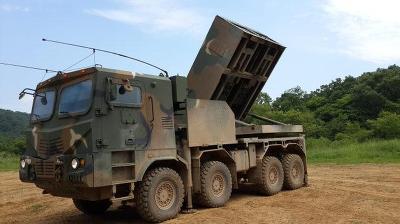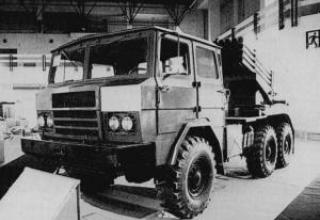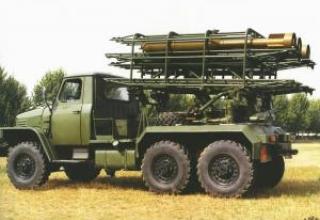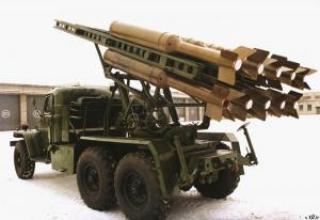The K-MLRS Cheonmoo (Chunmoo) experimental multiple launch rocket system is developed by South Korean Hanwha Corporation. The system is designed to replace the Kooryong combat vehicle in service for launching 130 mm caliber unguided rockets. According to the South Korean operational and tactical command, the main purpose of the system is to suppress DPRK's artillery systems in case of military conflict.
The development of K-MLRS Cheonmoo began in 2009, it was reported that firing tests were conducted (1). The current status of the work is unknown.
The K-MLRS Cheonmoo artillery unit is mounted on the modified chassis of a four-axle truck. This chassis type was chosen to reduce the cost of the system, its operation and maintenance costs. However, compared to the tracked chassis type, the wheeled chassis has less cross-country ability.
The artillery unit does not have a permanent package of rails. Two transport and launch containers of different types (1,2,3,4,5,6,7,8) are mounted on its platform.
The cockpit of the combat vehicle is armoured and provides protection of the calculation numbers against small-calibre weapons and artillery shell fragments. The roof of the cabin has a hatch (1).
The LM is equipped with a load-lifting device, probably similar to that of the MLRS LM. The recharging time is 10 minutes.
The system includes a transport and charging machine on an 8x8 chassis, which carries two sets of transport and discharge containers, i.e. four TPKs (1,2).
The Cheonmoo K-MLRS ammo includes 227 mm MLRS multiple rocket launchers, as well as 130 mm and 230 mm South Korean designed projectiles. The range of 130 mm rockets is up to 80 km, while that of 230 mm rockets is about 160 km.
Shots are fired from the cockpit of the fighting vehicle or remotely using the remote fire control.
The K-MLRS Cheonmoo system can be transported by military transport aircraft of C-130 type.
Composition:
Combat vehicle (BM) RSZO AR3 is mounted on a modified chassis of Wanshan off-road truck with the wheel configuration of 8×8. This type of chassis is used for all vehicles of Chinese large-caliber multiple rocket launchers recently developed (see for example AR1A). The combat vehicle has good cross-country and off-road capabilities and can be operated in various climatic conditions within the temperature range of minus 20 to plus 55 degrees Celsius.
The artillery unit of the BM AR3 includes two disposable quick-release transport and launch containers with four tubular guides of 370 mm caliber or five guides of 300 mm caliber. The containers are designed for storage, transportation and launching of rockets. Charging and sealing of transport and launch containers is performed at the factory. In accordance with the modern concept of building a universal multiple rocket launcher system, the use of detachable TPK provides the following advantages: reduced charging time, flexibility in organizing the charge of firearms, simplified logistics and maintenance.
The AR3 multiple rocket launcher kit includes uncontrollable and guided missiles.
Transport and launch containers of 370 mm caliber are designed for launching guided BRE6 missiles. Maximum range of missiles is 220 km, minimum range is 100 km. The value of the round probable deviation is no more than 50 meters. There is no information about the control system implemented in the BRE6 missile, but according to the developers, the capabilities of these missiles are similar to those of ballistic missiles with a short range.
Unmanned and guided 300 mm calibre rockets can be equipped with different types of warheads. These include fragmentation, incendiary, volume detonation, and cassette missiles equipped with anti-personnel, anti-tank mines and self- aiming warheads. Depending on the type of projectile, the maximum range of fire is between 70 and 130 kilometres.
Presumably, in terms of the composition of the used 300 mm caliber rockets, the AR3 MLRS is unified with the AR1A multiple rocket launcher system. According to NORINCO Corporation specialists, despite direct copying and borrowing of design elements of Smerch MLRS, 300 mm rocket launchers of AR3 system are original development and are incompatible with Russian analogues.
AR3 combat vehicles can be used as part of a battery, a division or for stand-alone tasks. The battery consists of combat vehicles, transport and charging vehicles, command (command and staff) vehicle, meteorological complex on the vehicle chassis, and other auxiliary vehicles.
Preparation of the combat vehicle for firing is carried out without leaving the cab. The time to prepare for firing is about 5 minutes. Rockets can be launched remotely. The time to leave the firing position after firing is about 1 minute. Rapid redeployment allows to evade counter-battery fire.
Behind each combat vehicle is a transport and charging machine, equipped with racks for transporting the TPK and a crane. The time of recharging the BM by two transport and launch containers is about 20 minutes. Usually, the recharging process takes place at a position far from the firing position in order to avoid counter-battery fire.
AR3 vehicle accessories include: a weapons of mass destruction protection system, fire control system, night vision devices, GPS positioning system, air conditioning system and tire pressure regulation system.
Characteristics:
| Variant on modified M720 chassis (standard) | |
| Total length, mm | 4347 |
| Total width, mm | 2044 |
| Total height, mm | 2580 |
| Battle weight, kg | 3000 |
| Maximum travel speed, km/h | 75 |
| Angle of elevation, deg: | |
| minimum | 0 |
| maximum | +55 |
| Angle of horizontal firing,°: | |
| to the right of the chassis axle | 120 |
| to the left of the driving axle | 120 |
| Precise guidance (finishing, finishing angles), °: | |
| right | 15 |
| left | 15 |
SAKR-10 Unguided Jet Projectile Data
| Header type | blast |
| The length of the projectile, mm | 1933 |
| Jet weight, kg | 44 |
| Weight of the head end, kg | 19,5 |
| The projectile's range, m: | |
| minimum | 3000 |
| maximum | 10800 (11000) |
Sources:
- http://enester.tistory.com/category/%EA%B5%B0%EC%82%AC%EC%A0%95%EB%B3%B4?page=2
- http://genk.vn/quan-su/han-quoc-phat-trien-phao-phan-luc-cheonmoo-doi-pho-trieu-tien-20140331223427958.chn
- http://greendef.blogspot.ru/2013/10/south-korea-has-developed-k-mlrs.html
- http://m.blog.daum.net/baba1905/2323918
- http://www.military-today.com/artillery/chunmoo.htm












